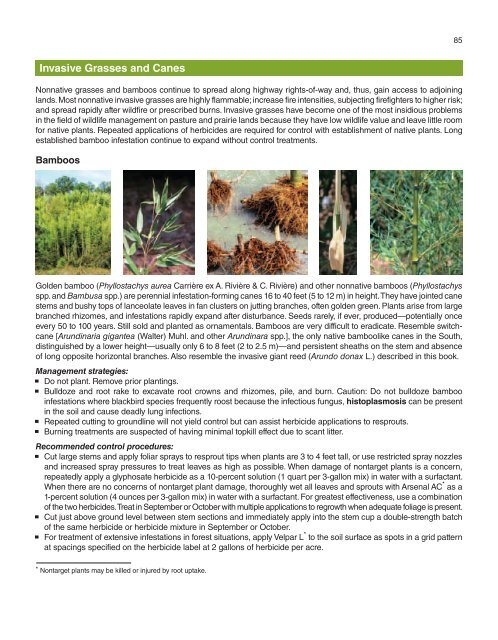A Management Guide for Invasive Plants in Southern Forests James ...
A Management Guide for Invasive Plants in Southern Forests James ...
A Management Guide for Invasive Plants in Southern Forests James ...
- No tags were found...
You also want an ePaper? Increase the reach of your titles
YUMPU automatically turns print PDFs into web optimized ePapers that Google loves.
85<strong>Invasive</strong> Grasses and CanesNonnative grasses and bamboos cont<strong>in</strong>ue to spread along highway rights-of-way and, thus, ga<strong>in</strong> access to adjo<strong>in</strong><strong>in</strong>glands. Most nonnative <strong>in</strong>vasive grasses are highly flammable; <strong>in</strong>crease fire <strong>in</strong>tensities, subject<strong>in</strong>g firefighters to higher risk;and spread rapidly after wildfire or prescribed burns. <strong>Invasive</strong> grasses have become one of the most <strong>in</strong>sidious problems<strong>in</strong> the field of wildlife management on pasture and prairie lands because they have low wildlife value and leave little room<strong>for</strong> native plants. Repeated applications of herbicides are required <strong>for</strong> control with establishment of native plants. Longestablished bamboo <strong>in</strong>festation cont<strong>in</strong>ue to expand without control treatments.BamboosGolden bamboo (Phyllostachys aurea Carrière ex A. Rivière & C. Rivière) and other nonnative bamboos (Phyllostachysspp. and Bambusa spp.) are perennial <strong>in</strong>festation-<strong>for</strong>m<strong>in</strong>g canes 16 to 40 feet (5 to 12 m) <strong>in</strong> height. They have jo<strong>in</strong>ted canestems and bushy tops of lanceolate leaves <strong>in</strong> fan clusters on jutt<strong>in</strong>g branches, often golden green. <strong>Plants</strong> arise from largebranched rhizomes, and <strong>in</strong>festations rapidly expand after disturbance. Seeds rarely, if ever, produced—potentially onceevery 50 to 100 years. Still sold and planted as ornamentals. Bamboos are very difficult to eradicate. Resemble switchcane[Arund<strong>in</strong>aria gigantea (Walter) Muhl. and other Arund<strong>in</strong>ara spp.], the only native bamboolike canes <strong>in</strong> the South,dist<strong>in</strong>guished by a lower height—usually only 6 to 8 feet (2 to 2.5 m)—and persistent sheaths on the stem and absenceof long opposite horizontal branches. Also resemble the <strong>in</strong>vasive giant reed (Arundo donax L.) described <strong>in</strong> this book.<strong>Management</strong> strategies:Do not plant. Remove prior plant<strong>in</strong>gs.Bulldoze and root rake to excavate root crowns and rhizomes, pile, and burn. Caution: Do not bulldoze bamboo<strong>in</strong>festations where blackbird species frequently roost because the <strong>in</strong>fectious fungus, histoplasmosis can be present<strong>in</strong> the soil and cause deadly lung <strong>in</strong>fections.Repeated cutt<strong>in</strong>g to groundl<strong>in</strong>e will not yield control but can assist herbicide applications to resprouts.Burn<strong>in</strong>g treatments are suspected of hav<strong>in</strong>g m<strong>in</strong>imal topkill effect due to scant litter.Recommended control procedures:Cut large stems and apply foliar sprays to resprout tips when plants are 3 to 4 feet tall, or use restricted spray nozzlesand <strong>in</strong>creased spray pressures to treat leaves as high as possible. When damage of nontarget plants is a concern,repeatedly apply a glyphosate herbicide as a 10-percent solution (1 quart per 3-gallon mix) <strong>in</strong> water with a surfactant.When there are no concerns of nontarget plant damage, thoroughly wet all leaves and sprouts with Arsenal AC * as a1-percent solution (4 ounces per 3-gallon mix) <strong>in</strong> water with a surfactant. For greatest effectiveness, use a comb<strong>in</strong>ationof the two herbicides. Treat <strong>in</strong> September or October with multiple applications to regrowth when adequate foliage is present.Cut just above ground level between stem sections and immediately apply <strong>in</strong>to the stem cup a double-strength batchof the same herbicide or herbicide mixture <strong>in</strong> September or October.For treatment of extensive <strong>in</strong>festations <strong>in</strong> <strong>for</strong>est situations, apply Velpar L * to the soil surface as spots <strong>in</strong> a grid patternat spac<strong>in</strong>gs specified on the herbicide label at 2 gallons of herbicide per acre.* Nontarget plants may be killed or <strong>in</strong>jured by root uptake.
















